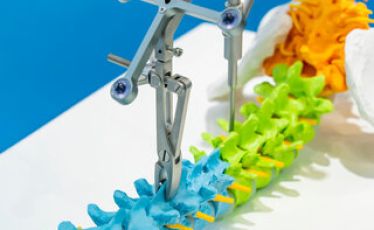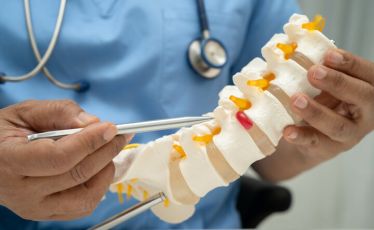+62 817-4929-054
Scoliosis: Symptoms, Causes, and Treatment Solutions

Oleh: dr. Ajiantoro, Sp.OT (K) Spine - Spesialis Orthopedi & Traumatologi Konsultan Spine
What is Scoliosis?
Scoliosis is a condition in which the spine curves sideways, forming a “C” or “S” shape with an angle of ≥10° (measured using the Cobb angle). This curvature can occur in various parts of the spine: thoracic, lumbar, or both.
Scoliosis Causes
- Idiopathic (~65–80%) – Most common type, especially in ages 10–18, with no clear cause. Genetic factors are involved, but the exact mechanism is unknown.
- Congenital (~15%) – Present at birth due to a deformity of the spine during fetal development.
- Neuromuscular (about 10%) – Related to muscle or nerve disorders, such as cerebral palsy, muscular dystrophy, or spinal cord injury.
- Degenerative – Occurs in adults due to aging, osteoarthritis, or disc deterioration – also known as degenerative scoliosis.
- Functional/non-structural – Temporary curvature due to external factors such as different leg lengths, muscle spasms, or pain.
Scoliosis Symptoms
- Shoulders, hips, or waistband appear asymmetrical
- One shoulder blade protrusion is more visible when bending over
- A mild curvature is usually painless; however, if severe, it can cause:
- Back pain and muscle tension.
- Numbness or leg pain due to nerve compression
- Difficulty breathing due to ribs being pushed through
When to See a Doctor?
See a doctor if you notice any of the following signs:
- Shoulders/hips not aligned, body leaning to one side
- Scapular protrusion during the “Adam’s forward bend” test. The doctor will perform a physical examination and imaging (X-ray, MRI if necessary) to measure the Cobb angle.
Curvature Degree & Treatment
Based on Cobb angle:
- Mild (10–24°): Routine monitoring every 3–12 months during growth.
- Moderate (25–45°): Use of a brace, especially while still growing, to inhibit curve progression.
- Severe (≥45–50°): Consider surgery (spinal fusion) to prevent the curvature from getting worse.
How to Reduce Pain & Maintain Posture
- Physical exercises and special therapies: Pilates, yoga, swimming, and core muscle exercises effectively strengthen the muscles that support the spine.
Methods such as Schroth help improve posture in three dimensions. - Bracing, TLSO type corsets (from the armpit to the hip) can prevent the curve from getting worse, especially during growth.
- Surgery. Spinal fusion with screws and metal rods to straighten the spine in severe cases.
Handling Summary
| Sudut COB | Penanganan |
|---|---|
| 10–24° (Mild) | Routine observation |
| 25–45° (Moderate) | Add corset + posture training |
| ≥ 45–50° (Severe) | Consider surgery |
Conclusion
Scoliosis is a curvature of the spine that can be controlled if treated early, for example through observation, exercise, or corsets. In severe cases, surgery is the best option. It is important to consult a doctor immediately when you find symptoms, to prevent complications such as chronic pain, respiratory problems, or more severe body deformities.
If you or your family experience symptoms of scoliosis, immediately consult Premier Bintaro Hospital for evaluation and treatment as needed - because early detection and appropriate intervention can help prevent the development of the condition and maintain quality of life.
Contact Us
For Information and to Make an Appointment

dr. Ajiantoro, Sp.OT (K) Spine
Orthopedi & Traumatologi View Schedule| Loading data... |
|---|

















